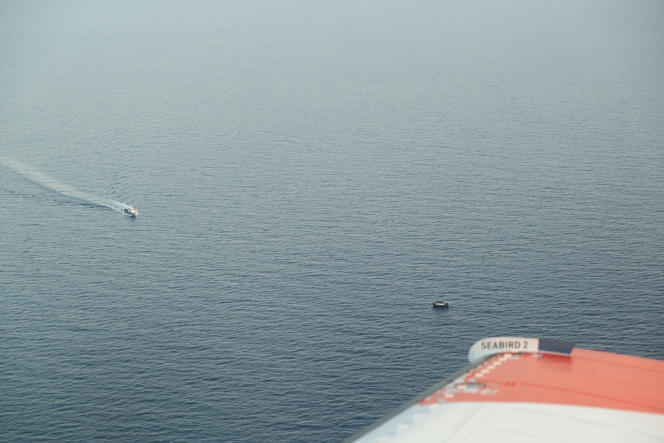Both engines are running at full throttle to allow the small plane to soar into the sky. In the distance, the Italian island of Lampedusa, from which the aircraft has just taken off, is no more than a thin silhouette. The Beechcraft Baron 58, chartered by the German NGO Sea-Watch to assist rescue operations in the central Mediterranean and monitor this vast area, has been in the air for a few moments, under the morning sun of this Thursday, July 6, and already his radio spits alarming communications. “Do you see the boat of the harraga [les migrants clandestins] ? He is next to you ? », asks a sailor, whose dialectal Arabic suggests that he is a Tunisian fisherman. “Yes, yes, he is right there, in front of me”, immediately replies his colleague and compatriot, worried.
“Radio Lampedusa, Radio Lampedusa? », then challenges one of the two men, on channel 16, the international distress frequency. To the local authorities who respond to him, he transmits key information in Italian: “an iron boat”, “40 people on board”, “the boat is taking on water”as well as the GPS position.
Several hundred meters above the Mediterranean, Samira, seated next to the pilot, does not miss a second of this conversation. On a piece of paper, the tactical coordinator on board – who wishes to be identified only by her first name – scribbles the ship’s coordinates. “I would like us to go and see”, she asks. The plane turns sharply. Its five passengers scan the sea with binoculars, before spotting the boat in distress. On board this metal shell that left Tunisia, men, women and children from sub-Saharan Africa.
iron boats
In this corner of the Mediterranean, these boats are part of the landscape. But the number of departures from Tunisia has exploded this year. “There have always been migrations from Tunisia, but the use of this route has increased massively”, Samira analysis. “Nationalities have also changed, especially since the speech of the Tunisian president”, she continues with reference to the remarks of Kaïs Saïed, who in February denounced the “hordes of illegal immigrants” whose presence in the country would, according to him, be a source of “violence, crimes and unacceptable acts”.
The words of the head of state and the violence that followed them have prompted many sub-Saharans to take to the sea. Since the beginning of the year, 37,000 people have arrived in Lampedusa from Tunisia, according to the High Commission United Nations for Refugees, an increase of 567% compared to the same period a year ago. Tunisia is now ahead of Libya as the main point of departure to Europe, and its nationals, who in the past constituted the first contingent on this corridor, have been supplanted by Ivorians and Guineans, the majority among travellers.
You have 64.14% of this article left to read. The following is for subscribers only.
